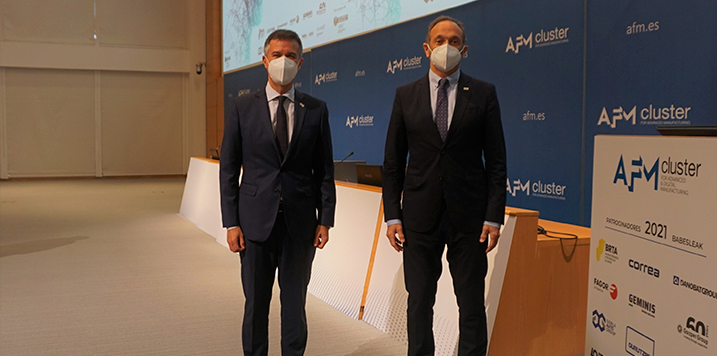 12 May, 2021
12 May, 2021The final year-end figures have confirmed what the sector predicted in February with the provisional figures: sales were ultimately 19.65% below the 2019 figure. In absolute terms, the final sales figure for the sector in 2020 was Euros 1,324.12 million, compared to Euros 1,647.86 million for 2019. The drop in production in Spain was in line with the worldwide 19.18% decrease in manufacturing.
The drop is slightly more pronounced in the metal-forming subsector, which, at Euros 311.07 million, fell by 21.82%, while metal cutting machines, at Euros 559.42 million, fell by 18.68%. All other subsectors also fell with respect to 2019: components and tools was down by 15%, other machines were down by 17.72%, accessories by 52.76%, and machining and other services by 9.31%.
Due to the travel and transport restrictions put in place, exports fell by 22.25%, to Euros 1,006.01 million, compared to the Euros 1,293.93 million recorded in 2019, and they represent 76% of overall production. In this case, metal cutting and metal-forming have recorded similar decreases, of 22.57% and 22.44%, respectively.
Sales by national manufacturers on the domestic market are down by 13.41% in 2020. For its part, apparent consumption (production+imports+exports) of machine-tools in Spain has declined by 31.13%.
EXPORT DESTINATIONS
Export sales in 2020 were mainly to: Germany, with a 11.8% share of our exports, USA, with 10.3%, France, with 9.1%, Italy, with 7.3%, and China, with 7.3%. The other countries in the top ten for exports are Mexico, Portugal, India, United Kingdom and Russia.
New orders for the year show a different trend, with a significant surge from China, which has taken the lead in the market, ahead of Germany and the United States. These are followed by Turkey, France, Italy, India, Russia and Canada. The rapid reactivation of industrial activity in China (where GDP only fell in the first quarter of 2020) has enabled the country to invest widely, taking the advantage over the other countries.
SOLID INTERNATIONAL POSITIONING
Despite the pandemic onslaught, Spain has stood its ground as the world’s tenth manufacturer and exporter, retaining its market share. The five main manufacturing countries have held their positions in the ranking: China, Germany, Japan, USA and Italy, the latter two switching positions with respect to 2019.
The decreases in production in these five countries are also relevant, particularly in the case of Germany (-30.9%) and Japan (-29.3%). Italy shows a similar drop to Spain (-23%), somewhat less prominent in the USA (-9.4%) and very slight in China (-1.3%).
World consumption fell by 20.1% in 2020, which is quite a bit below the slump recorded in 2009. The forecast for 2021, however, points toward 15% growth, which would lead to an increase of 7.5% in 2022, although the speed of recovery is expected to vary significantly between the three main areas of consumption: Asia, Europe and America.
ORDERS
As provisionally reported in February, orders recorded in 2020 fell by 23.5% with respect to 2019 figures. In terms of subsectors, metal-forming was worst hit, plummeting by 34.7% and metal cutting, which fared marginally better, saw a drop of 17.65%.
We should highlight that from October 2020, orders began to recover steadily and this positive dynamic has been sustained throughout the first term, with similar order figures to 2019. The duration of this upswing remains to be seen and it may, in part, be attributable to the rebound effect of the global industry lockdown in the first half of 2020.
Our main European competitors, along the same lines, are reporting significant increases in orders coming in: Italy, has recently reported a 48.6% growth in orders received in the first quarter of 2021 and Germany is expecting the rate of orders from China (which grew by 17% in the last quarter of 2020) to have a favourable effect in the coming months. Our forecasts indicate a strong rise in orders received, close to 25%, for 2021 overall.
2021, THE PATH OF RECOVERY
The strong upsurge in demand on the Chinese market and the expectations generated by Joe Biden’s plan to boost the US economy, are giving hope of a strong recovery in the world economy, which should also be accompanied by greater momentum in Europe, driven by the acceleration of vaccination processes and the layout of recovery funds.
Subject to what happens in the second quarter, the favourable though disparate amount of orders received in the last six months brings forecast sales growth for 2021 to around 12-15%.
With regard to user sectors, although the automotive industry bounced back to the levels of activity prior to the stoppage forced by the outbreak of the pandemic, the transition towards electric and hybrid vehicles, on the one hand, and changes relating to the mobility model, on the other, are making it hard to predict vehicle demand, which is slowing down investments.
The aeronautics sector, for its part, has felt the impact of the decline in mobility and, other than in the area of defence, forecasts are not good for the next 2-3 years. The railway sector, on the other hand, is doing well, while the energy sector, recording disparate realities, is still showing a gradual shift towards renewable sources.
R3, PLAN TO RELAUNCH THE DIGITAL AND SUSTAINABLE MANUFACTURING INDUSTRY
In its defence of the industry as the backbone of all developed and sustainable economy, AFM has been working in recent months on developing and presenting the strategy to reactivate manufacturing activity.
In the short term, this strategy entails many support measures for activity and jobs, re-equipping the industry base and an ambitious sector transformation project known as the “e-Machine Digital Workshop”, which focuses on digitalisation and sustainability. In its work to support the sector’s businesses, AFM Cluster continues to strive towards securing the goals set.
Subscribe to our newsletter. Just insert your e-mail and you will receive the latest news.